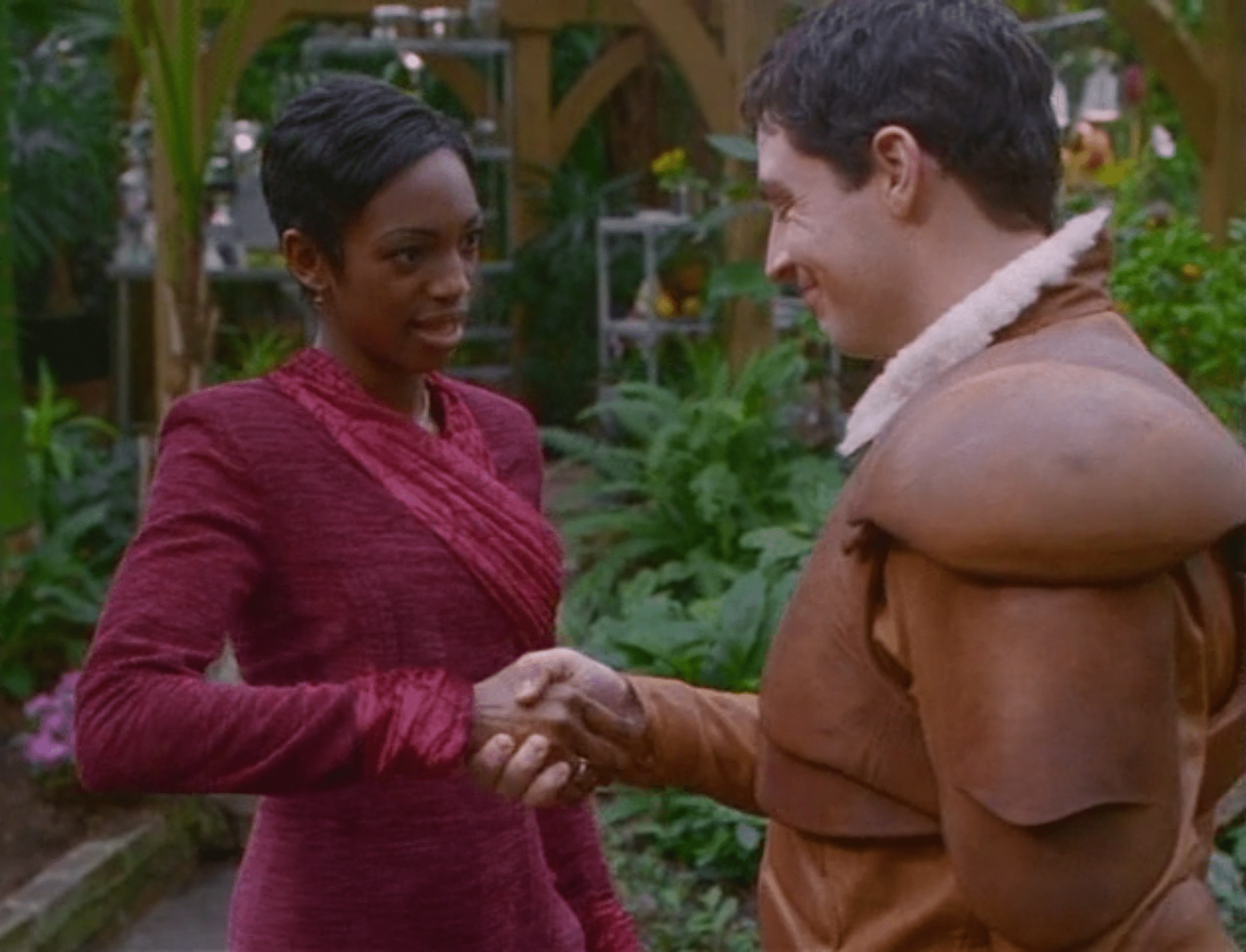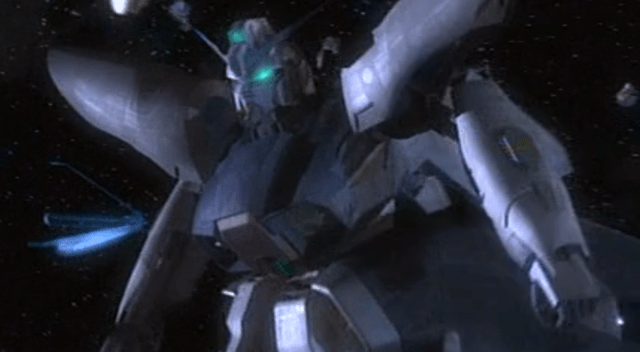Netflix’s acquisition of Legendary’s long-in-gestation plans to help bring Sunrise’s Mobile Suit Gundam to the world of Hollywood is bringing us one step closer to reimagining the iconic franchise. But it’s not the first time Gundam tried to take on Hollywood… and it’d be hard-pressed to turn out something as bad as the attempt Sunrise would like to forget.
Created as part of the “Gundam Big Bang Project” — a 20th-anniversary celebration of the Gundam franchise first released in 1999 that paired this Canadian-made TV movie with, grimly, the excellent anime series Turn A Gundam in Japan — G-Saviour (the word “Gundam” is never uttered in its 90-odd minute runtime) is a strange thing to revisit in the hindsight of Netflix, Legendary, and Sunrise’s partnership.
The art of adaptation is a heady balance of understanding what made the source material so compelling in the first place with the understanding of what can be brought to the table by presenting it in a new light and a new medium. In the late ‘90s, the Gundam franchise was no stranger to movies — compilation films of the original Mobile Suit Gundam, alongside the now-iconic model kit merchandise that followed, are arguably what revitalised the series after the original anime was cut short in its first broadcast run. But in not just translating itself to a primarily Western audience, but the realm of live-action, G-Saviour had to navigate some lofty hurdles, technological and cerebral, to try and succeed.
It… mostly fails miserably at it, perhaps to a few surprises. There’s a reason that G-Saviour is barely remembered, and even Sunrise and Bandai are reticent to acknowledge it. But what is surprising is that, well, G-Saviour actually kind of tries, in some ways, to bring elements of what makes Gundam work outside of the giant mecha to the table. It’s all just surface level to a movie that spends way (way) too long trying to decide it’s a sci-fi action movie with some borderline-questionable-even-for-late-‘90s CGI or the most turgidly paced romance movie you can imagine.

Set in Gundam’s primary “Universal Century” timeline in the year 0223 — almost 150 years after the events of the original Mobile Suit Gundam — G-Saviour follows Brennan Elliott’s Mark Curran. He’s a former pilot turned independent undersea miner working at a corporation trying to help research and solve an interstellar food crisis wracking CONSENT (the Congress of Settlement Nations), the evolution of Gundam’s original Earth Federation and several space colonies from the series. When Mark inadvertently helps his former CONSENT commander (Intelligence’s David Lovgren) stop a theft on his mining station, he finds himself drawn into political machinations far beyond his station. That, and suddenly on the run with Cynthia (Enuka Okuma), a scientist from one of the “rebel” colonies, Gaea, who is trying to research sustainable ways to grow food underwater — which would bring an end to Earth and the colonies’ (now dubbed “settlements”) agricultural yield issues. Hunted by his former colleagues and desperate to see Cynthia and her research freed from being buried by CONSENT, Mark finds himself thrust back into the military life when he’s given the chance to aid Gaea as the pilot of a top-secret advanced Mobile Suit: the titular G-Saviour.
All of this sounds pretty Gundam. Honestly, even if it’s clunkily delivered in the manner and production budget of a late ‘90s TV movie, that’s one of the rare things that actually works about G-Saviour. Even if only diehard fans who know their Kycilias from their Kamilles will strain to appreciate it, in a loose sense the film knows how to gesture at what made Mobile Suit Gundam’s worldbuilding so appealing for 20 years at that point. Beyond the signals towards the military suit designs from the anime, CONSENT as an evolution of the Federation makes sense — a force that was, ostensibly, the “good guys” of the original Gundam, but presented in that series (and series since in the “UC” timeline) as much more complicated and often morally worse than its foes.
CONSENT from the get-go is depicted as corrupt, willing to allow horrifying injustices to continue to hold power over Earth and the colonies. It’s also as quick to deify Mark as it is to turn him into a scapegoat in their plans to crush Gaea and other independent colonies. Painting the independent space settlements as sinister rebels out to undermine order pulls on everything from Zeta Gundam and Double Zeta’s Anti-Earth Union Group to the Gundam Scientists of the then-recent Gundam Wing, as Mark finds himself having to turn his back on his entire life to realise that the powers that be above him aren’t who they seem.

While it’s ultimately clear in G-Saviour who’s bad and who’s good, the fact that it’s Earth that’s in the wrong and not cackling-ly openly evil, invading everywhere (well… more on that later) through force but oppressing its civilian population through state media and silencing agricultural scientists is, at least interesting. It’s a twist on the typical clear cut morals you’d expect out of a sci-fi action movie, and something that genuinely feels like, at some point somewhere in the line of production, someone actually understood what Gundam was about more than “there’s a robot and it’s called a Gundam.” But! — that’s a big but — it’s very kind to G-Saviour because all of the above is very light background stuff, none of which will hit anyone but people already intimately familiar with what Gundam is.
And those people are still going to be frustrated anyway, because G-Saviour is actually a 90-minute movie that’s about 60 minutes of a bad romantic comedy that just so happens to be in a sci-fi setting, and 30 minutes of a late ‘90s made-for-TV sci-fi action flick, all of which manages to move at a pace so excruciating those minutes pass feeling like they’re three times that. The awkward romance between Mark and Cynthia dominates the opening and much of the movie, and it’s not helped by the clunky script nor Okuma and Elliott’s icy chemistry with one another not really selling the romance. It’s made unnecessarily complex too, by the fact Mark actually has a partner for much of the movie, Mimi (Catarina Conti), who primarily exists to perform about three heel-turns during the process of discovering her boyfriend fell for a random space scientist in the space of about 48 hours.

That, combined with the glacial pacing, means that by the time the film is ready to flip into an action-packed, Mobile-Suit-filled action climax, the tonal disparity is so severe and so sudden that it’s just immediately jarring. Watching G-Saviour is like being lulled into a coma and only being woken up by someone trying to shear your arms off. But that someone happens to be dodgy CGI effects that sort of look like a giant robot you know fighting another giant robot you know. By the time the dust has settled, the day is saved, and Mark’s got his girl, you’re still trying to wonder what the hell actually happened for the last 90 minutes, rather than being given a sense of narrative satisfaction.
Time will tell just how Netflix’s Gundam adaptation will tackle balancing the franchise’s wider themes about class and war with the real-robot mecha action fans crave, especially in the constraints of a movie runtime rather than the massive series and OVAs that make up the bulk of the Gundam franchise’s work. But it’d take a special kind of misfire to get it as wrong as G-Saviour does, choosing to only briefly touch on the bits that make the series so fascinating in the first place — whether it’s the titular Mobile Suits themselves, or the sociopolitical commentaries beyond them — in favour of a tepid, forced romance that barely attempts to capture the human elements of the series, either.
